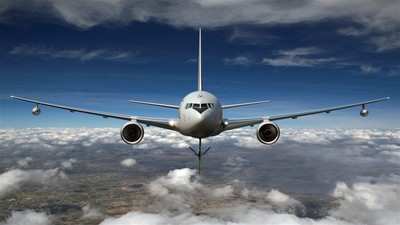Tue, Jan 15, 2008
American Planemaker Says USAF Would Benefit From Savings
While perhaps not as headline-grabbing as the news EADS plans to
build the upcoming Airbus A330 Freighter in Alabama -- but only if
its KC-30 tanker wins a US Air Force competition -- Boeing also had
some news to share Monday regarding its entrant in the KC-X bid.
The American planemaker publicized the results of a Conklin &
de Decker study, showing Boeing's commercial 767 is far more fuel
efficient than its nearest Airbus competitor.

In the study -- which was funded by Boeing -- Conklin
& de Decker used published data to calculate the fuel
consumption of flying a fleet of 179 767-200ER and Airbus 330-200
airplanes over a 40-year service life. Boeing says the purpose of
the analysis was to provide a comparison between the KC-767
Advanced Tanker, based on the 767, and its major competitor in the
US Air Force's KC-135 Tanker Replacement Program... the KC-30.
The winner of the KC-X competition will supply 179 new aircraft
to begin replacement of the service's aging refueling
inventory.
Boeing reports the study showed the 767 fleet burned 24 percent
less fuel than the A330s, and would save approximately $14.6
billion in fuel costs. That number is significant since the Air
Force spent approximately $6.6 billion on aviation fuel costs in
2006.
"Senior Air Force leaders have said that when a barrel of oil
increases by $10, it costs them about $600 million a year," said
Mark McGraw, vice president, Boeing Tanker Programs. "So it is
critical, especially with rising fuel prices, that the Air Force's
next refueling tanker meet or exceed their requirements and be as
efficient as possible."
It's impossible to draw a direct comparison between the
767-200ER and the A330-200, as the Airbus plane -- and, thus, its
tanker variant -- is notably larger. Airbus is leveraging this
difference by noting the KC-30 could fulfill a variety of roles in
addition to the primary use as a tanker.
Conversely, Boeing says the KC-767 is "right-sized," and
fulfills all the Air Force's requirements... without lugging added
space and weight around.
More News
Aero Linx: Model Aeronautical Association of Australia MAAA clubs are about fun flying, camaraderie and community. For over 75 years, the MAAA has been Australia’s largest fl>[...]
Touchdown Zone Lighting Two rows of transverse light bars located symmetrically about the runway centerline normally at 100 foot intervals. The basic system extends 3,000 feet alon>[...]
“Discovery and innovation are central to our mission at Virgin Galactic. We’re excited to build on our successful record of facilitating scientific experiments in subor>[...]
How To Get A Story On Aero-TV News/Feature Programming How do I submit a story idea or lead to Aero-TV? If you would like to submit a story idea or lead, please contact Jim Campbel>[...]
Student Pilot Reported That During Rotation, “All Of A Sudden The Back Of The Plane Kicked To The Right..." Analysis: The student pilot reported that during rotation, “>[...]
 ANN's Daily Aero-Linx (05.02.24)
ANN's Daily Aero-Linx (05.02.24) ANN's Daily Aero-Term (05.02.24): Touchdown Zone Lighting
ANN's Daily Aero-Term (05.02.24): Touchdown Zone Lighting Aero-News: Quote of the Day (05.02.24)
Aero-News: Quote of the Day (05.02.24) ANN FAQ: Contributing To Aero-TV
ANN FAQ: Contributing To Aero-TV NTSB Final Report: Cirrus Design Corp SR20
NTSB Final Report: Cirrus Design Corp SR20



